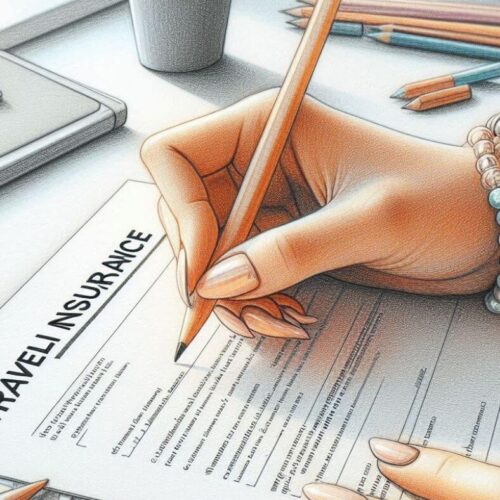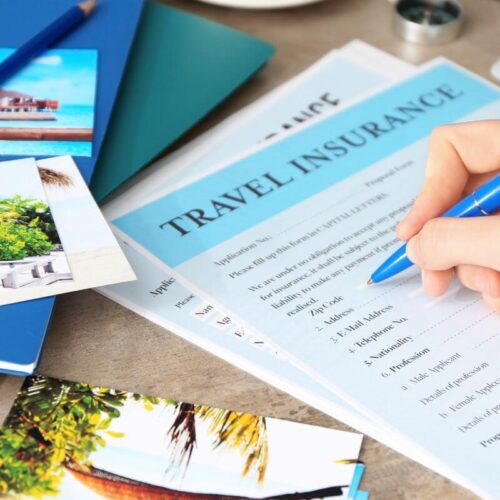The charm of European small towns like Hallstatt in Austria, Bruges in Belgium, and Sintra in Portugal await you. But before you dive into your European adventure, there’s one crucial thing you shouldn’t overlook: Single-Trip Travel Insurance. Now, I know what you’re thinking, “Insurance? Yawn!” But trust me, this could be the most important decision you make before jetting off.

Let’s break it down, keep it light, and ensure you’re well-prepared for your European escapade.
Why You Need Single-Trip Travel Insurance
You might be tempted to skip the insurance part, thinking, “What’s the worst that could happen?” Well, let’s consider a few scenarios in a bit more detail:
- Medical Emergencies: European healthcare is fantastic but not free for tourists. A sudden illness in the quaint town of Rothenburg ob der Tauber, Germany, could leave you with a hefty bill. Even a minor incident, like a sprained ankle from tripping over a cobblestone in Prague, can lead to unexpected medical expenses. Hospitals and clinics will expect you to pay upfront if you don’t have insurance, and those costs can add up quickly.
- Trip Cancellations or Interruptions: Flights can get delayed, and plans can change. Having insurance means you won’t lose all your money if something unexpected happens. For instance, if you’ve booked a beautiful villa in Tuscany and a family emergency back home forces you to cancel your trip, trip cancellation insurance can help recover the costs. Similarly, if a volcanic ash cloud decides to play spoilsport with your travel plans, having interruption coverage ensures you’re not stranded without help.
- Lost or Stolen Belongings: Imagine losing your camera in the bustling markets of Siena, Italy. Travel insurance can help you replace stolen or lost items without breaking the bank. In tourist hotspots, pickpocketing can be an issue. Insurance can cover the replacement costs for your valuables, and in some cases, even assist with getting new travel documents if your passport is stolen.
- Peace of Mind: Knowing you’re covered allows you to enjoy your vacation without worrying about what could go wrong. This is perhaps the most underrated benefit. Travel should be about creating wonderful memories, not stressing over potential problems. Insurance gives you the confidence to explore and enjoy without constantly looking over your shoulder.
What to Look for in a Single-Trip Travel Insurance Policy
When shopping for Single-Trip Travel Insurance, keep an eye out for these key features:
1. Medical Coverage
Ensure your policy covers medical expenses, including hospitalization, doctor visits, and emergency medical evacuation. A walk through the cobblestone streets of Český Krumlov, Czech Republic, shouldn’t end in financial ruin if you twist an ankle. Look for policies that offer comprehensive coverage, including dental emergencies, which are often overlooked. If you have a pre-existing medical condition, make sure your policy includes a waiver for it. Some insurers offer coverage extensions for chronic conditions, so it’s worth investigating those options.
2. Trip Cancellation and Interruption
Look for coverage that reimburses you if your trip gets canceled or cut short due to unforeseen events like illness, natural disasters, or other emergencies. If a sudden storm sweeps through the canals of Giethoorn, Netherlands, and your trip gets interrupted, you’ll want to be compensated. Additionally, check if the policy covers cancellations due to work-related reasons or personal emergencies like a family member falling ill. Some policies also cover non-refundable expenses such as concert tickets, guided tours, or cooking classes you booked in advance.
3. Baggage and Personal Belongings
Make sure your policy covers lost, stolen, or damaged luggage and personal items. Losing your bag with all those souvenirs from the charming shops of Colmar, France, would be devastating without proper insurance. Look into the limits of coverage for valuables like electronics, jewelry, and cameras. Some policies offer higher limits or the option to add additional coverage for these items. Also, check the process for filing a claim for lost or delayed baggage – some insurers offer compensation for essential items if your luggage is delayed for more than a certain number of hours.
4. 24/7 Assistance Services
Good insurance provides 24/7 customer service to help you in emergencies. Whether you need a translator in the remote village of Gimmelwald, Switzerland, or help finding a local doctor in Eze, France, having support on call is invaluable. Look for insurers that offer multilingual assistance and can help with everything from medical referrals to legal advice. Some policies also include concierge services that can assist with travel arrangements, like rebooking flights or arranging transportation in case of emergencies.
5. Adventure Sports Coverage
If you plan on skiing in Chamonix, France, or hiking the Cinque Terre trails in Italy, ensure your policy covers adventure activities. Not all insurance policies do, so read the fine print! Adventure sports can significantly increase your risk of injury, so it’s crucial to have adequate coverage. Check for exclusions and whether you need to pay extra to include activities like scuba diving, mountain biking, or zip-lining. Some policies also offer coverage for equipment rental if your gear gets lost or damaged.
How to Choose the Right Single-Trip Travel Insurance
Choosing the right policy might seem daunting, but it doesn’t have to be. Here are some steps to help you out:
1. Assess Your Needs
Think about your trip itinerary. Are you visiting multiple countries, or staying in one place? Will you be engaging in any risky activities? Tailor your coverage to match your specific plans. Consider the duration of your trip and the destinations you will be visiting. Some countries have higher medical costs or are more prone to natural disasters, which might influence your insurance needs. If you’re traveling with family, look for family plans that offer coverage for all members under a single policy.
2. Compare Policies
Don’t just go for the first policy you find. Use comparison websites to look at different options and prices. Sites like InsureMyTrip and Squaremouth are great for this. Compare not just the price, but also what’s covered. Pay attention to the coverage limits, exclusions, and the fine print. Look at user reviews and ratings to gauge the reliability of the insurer. Some insurers offer customizable plans where you can add or remove specific coverages based on your needs, so explore those options as well.
3. Read Reviews
Check out reviews from other travelers. Did they have a smooth claims process? Was the customer service responsive? Real-life experiences can give you valuable insights. Look for reviews that detail the claims process, as this can be a critical aspect of your experience. Some insurers might offer excellent coverage but have a cumbersome claims process, which can be frustrating when you need quick assistance. Platforms like Trustpilot and Reddit can provide unfiltered reviews from fellow travelers.
4. Understand the Fine Print
Read the policy documents thoroughly. Understand what’s covered, what’s excluded, and any conditions that apply. If something isn’t clear, don’t hesitate to ask the insurer. Pay close attention to clauses related to pre-existing conditions, age limits, and activity exclusions. Ensure you understand the claims process, required documentation, and the timeline for filing a claim. Knowing these details beforehand can save you a lot of hassle if you need to use the insurance.
Related Story: The Ultimate Guide to Travel Insurance Promotions in 2024
Tips for Using Your Single-Trip Travel Insurance
Once you’ve purchased your Single-Trip Travel Insurance, there are a few things you should do to ensure you can make the most of it if needed:
1. Keep Your Documents Handy
Carry a copy of your insurance policy, along with contact numbers for your insurer. Keep digital copies on your phone and physical copies in your luggage. Ensure that your travel companions also have access to these documents in case you are unable to provide them yourself. Consider storing important documents in a cloud storage service like Google Drive or Dropbox for easy access from anywhere.
2. Know Your Coverage Limits
Be aware of your coverage limits for medical expenses, baggage loss, and trip cancellations. This will help you understand what you can claim. Familiarize yourself with the deductibles and the maximum amounts payable under different categories. Knowing these limits can help you make informed decisions if you need medical treatment or face a loss. Some policies offer an option to increase coverage limits for an additional premium, so explore this if you feel the standard limits are insufficient.
3. Report Incidents Promptly
If you need to make a claim, report the incident to your insurer as soon as possible. Whether it’s a medical emergency or lost luggage, prompt reporting can help expedite your claim. Keep a record of all communications with your insurer, including emails and phone calls. Some insurers offer mobile apps that allow you to report claims and upload documents directly from your smartphone, making the process faster and more convenient.
4. Keep Receipts and Documentation
For any claims, you’ll need to provide proof. Keep receipts, medical reports, police reports, and any other relevant documentation. This will make the claims process smoother. For lost or stolen items, ensure you file a police report as soon as possible and obtain a copy for your records. In the case of medical claims, get detailed invoices and medical reports from the healthcare provider. Keeping a travel diary can also be helpful, as it allows you to document incidents and expenses accurately.
FAQs about Single-Trip Travel Insurance
Let’s address some common questions first-time travelers might have:
Q: Do I really need Single-Trip Travel Insurance?
A: Absolutely! It’s better to be safe than sorry. Medical emergencies, trip cancellations, and lost belongings can happen to anyone. Insurance provides a safety net. Even if you’re traveling on a budget, the potential costs of an unforeseen event far outweigh the price of a good insurance policy. It’s a small investment for a lot of peace of mind.
Q: How much does Single-Trip Travel Insurance cost?
A: It varies based on the length of your trip, your age, and the coverage you choose. On average, it can cost between 4-10% of your trip’s total cost. Younger travelers generally pay less, while older travelers may face higher premiums due to increased risk factors. Some insurers offer discounts for families or groups, so it’s worth checking if you can get a better rate by purchasing multiple policies together.
Q: Can I buy travel insurance after booking my trip?
A: Yes, you can buy travel insurance any time before your trip starts. However, purchasing it soon after booking can give you additional benefits like coverage for pre-existing conditions. Many insurers offer a window of 10-21 days from the date of your first trip payment during which you can buy insurance and still get coverage for pre-existing conditions. Also, buying early ensures you are covered for any issues that arise before your departure, like a sudden illness or a family emergency.
Q: What if I need to cancel my trip?
A: If you have trip cancellation coverage, you can get reimbursed for non-refundable expenses if you cancel for a covered reason, like illness or natural disasters. Review the list of covered reasons in your policy to understand what qualifies. Some policies offer “cancel for any reason” (CFAR) coverage for an additional premium, which allows you to cancel your trip for reasons not typically covered by standard insurance and still receive partial reimbursement.
Q: What should I do if I lose my belongings?
A: Report the loss to local authorities (like the police) and get a report. Contact your insurer with the report and any receipts for the lost items to file a claim. In the case of delayed baggage, keep receipts for any essential items you purchase while waiting for your luggage, as some insurers will reimburse these expenses. Make sure to notify your airline or transportation provider about lost or damaged luggage as soon as possible and obtain a written report from them.
Q: Are adventure activities covered?
A: It depends on the policy. Some policies cover activities like skiing or hiking, but others may not. Make sure to check the policy details and consider adding extra coverage if needed. If you’re planning on engaging in high-risk activities, look for policies specifically designed for adventure travelers. These policies often include coverage for emergency rescue and evacuation, which can be critical if you’re in a remote location.
Final Thoughts
Planning a trip to Europe is an exciting adventure, but it comes with its share of uncertainties. Single-Trip Travel Insurance is your safety net, providing peace of mind and financial protection. From the picturesque streets of Hallstatt to the medieval charm of Bruges, having the right coverage ensures you can focus on enjoying your journey.
So, as you plan your itinerary, pack your bags, and dream of European escapades, make sure to add Single-Trip Travel Insurance to your checklist. It might just be the best travel companion you take along on your journey.
Safe travels and happy exploring! 🌍✈️
Follow me on:




I never would have thought of having insurance for a trip! Thanks for sharing this info!